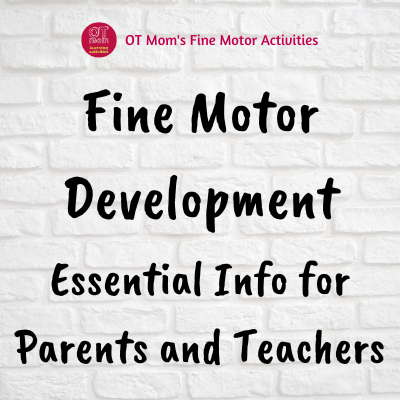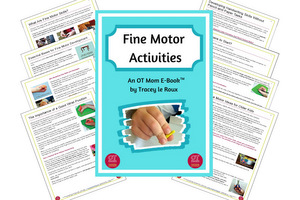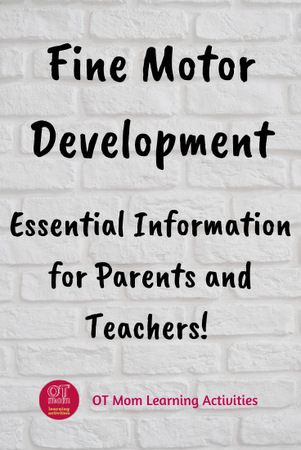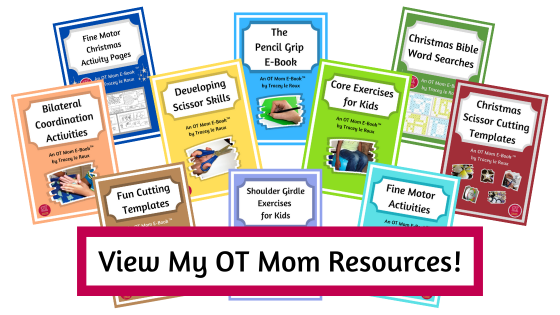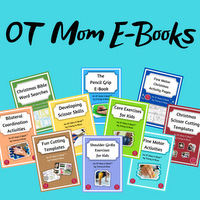- Home Page
- About Fine Motor Skills
- Fine Motor Development: essential information
Fine Motor Development
Fine motor development is is about developing skilled, coordinated movements of the small muscles in the hands and fingers. These are important for many of your child's daily activities, from buttoning clothes and tying shoelaces to writing, drawing, and using scissors.
Good fine motor skills can help a child to function independently and to learn effectively in school. This article aims to help you understand and support your child's fine motor progress!
I sometimes link to products (#Ad) that are similar to those I use and love. If you do purchase something through my links, I will receive a small commission that helps support my site - thank you!
-* Haz click aquí para español: Desarrollo de la Motricidad Fina
Fine Motor Milestones
Understanding how normal fine motor skills progress by age helps parents track their child's development. Here's a fine motor skills outline by age that shows key fine motor milestones that children should be achieving as they get ready for, and commence, formal learning.
These ages are approximate, and school requirements may differ across the world. Remember that each child develops at their own pace, so don't feel pressured to compare your child to others. However, do reach out to your health professional if you are concerned about anything.
Fine Motor Milestones for 3-4 Year Olds
- Makes snakes and balls with playdough
- Builds towers with small blocks
- Uses the non-dominant hand to assist the dominant hand
- Snips paper with scissors and may be able to cut along straight lines
- Fastens buttons and zippers with some assistance
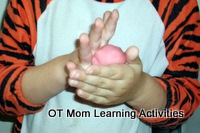 Rolling a playdough ball
Rolling a playdough ballFine Motor Milestones for 4-5 Year Olds
- Cuts along a straight line and cut out simple shapes
- Holds and manipulate a pencil
- Uses a pencil to copy and draw shapes and numbers
- Manages buttons and zippers independently
- Threads beads onto a string
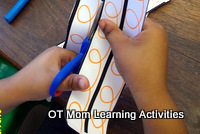 Cutting on a line
Cutting on a lineFine Motor Milestones for 5-6 Year Olds
- Uses scissors to cut out more complex shapes
- Starts to manage shoelaces
- Starts to manage a ruler
- Uses a 3 fingered grasp on the pencil and use small finger movements to control the pencil
- Uses a pencil to draw more detailed pictures
- Colors within the lines
- Able to use glue and paste appropriately
- Uses a knife and fork at mealtimes
 Tying shoelaces
Tying shoelacesFine Motor Milestones for 6-7 Year Olds
- Able to cut complicated shapes neatly with scissors
- Ties shoelaces independently
- Uses a knife and fork confidently and neatly
- Controls the pencil to write on the lines
- Can keep up with writing tasks in class
- Shows increased competence in arts and crafts
 Using a knife and fork
Using a knife and forkFine Motor Milestones for 7-8 Year Olds
- Good pencil control enables detailed drawing and extended periods of writing
- Developing the dexterity needed to build models, to knit or to sew
- Able to use rulers and compasses fairly accurately
- Has the finger control needed for tying complex knots (eg macramé, scouting knots) and more delicate beadwork
- Able to learn a musical instrument and/or keyboarding/typing skills
 Child learning to knit
Child learning to knitFine Motor Milestones for 8-10 Year Olds
- Able to engage in more complex and intricate hobbies such as braiding hair, building models, sewing, crocheting, painting etc
- Greater coordination and dexterity shows in mastery of musical instruments
- Proficient in typing (keyboarding) and using a computer mouse
- Efficient pencil control enables fluid handwriting (print or cursive)
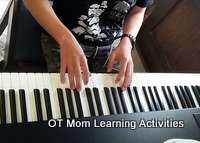 Playing a keyboard
Playing a keyboardEssential Foundations for Developing Fine Motor Skills
By preschool, most children can grasp objects effectively, scribble, and stack blocks. Kindergartners typically begin to master using scissors, copying shapes, and writing simple letters. In early elementary, children refine their pencil control for writing and drawing, and learn to master other tools.
However, these fine motor skills don’t develop in isolation from the rest of your child's progress. If you're wondering something like "why does my child struggle with writing and fine motor tasks?", then understanding these four essential foundations could help you to see other areas where your child may need more practice.
As an occupational therapist, I like to think of a child’s fine motor development as a 4-legged stool, with different factors influencing the overall development of fine motor skills.
Each leg of the stool represents one of the foundations for fine motor skills. When one of those legs is missing, or misshapen, the stool will wobble and topple over.
Each of the legs has to be in place in order for the stool to be stable.
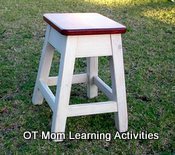 ...like a 4-legged stool
...like a 4-legged stoolBelow, I have highlighted 4 different aspects of child development and how they can impact fine motor skills.
Foundation 1: Postural Stability
When the bigger muscles of the shoulder girdle and trunk are strong and stable, the smaller muscles of the arms and hands can move freely in a controlled way.
Therapists refer to this as "postural control and stability".
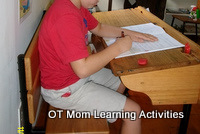 Postural Stability
Postural StabilityA child with poor postural stability...
- may hold the pencil really tightly to try and get more control over it
- may press really hard on the paper
- may show tension at the shoulders during fine motor tasks
Read more about shoulder girdle and core stability .
Foundation 2: Touch Perception
If you are not getting good sensory feedback from your fingers, it is hard to be accurate with them! Poor touch perception may feel like wearing thick gloves.
Even if nothing is wrong with the nerves in the hands, the brain is not processing the information from the hands properly, and so fine motor development is not optimal.
 Poor tactile perception can feel like wearing rubber gloves
Poor tactile perception can feel like wearing rubber glovesA child with poor touch perception...
- may be really clumsy with their hands, always dropping small items and letting things slip out of their grasp.
- may hold items with too much force, so they can "feel" it properly
- may press really hard on the paper with their pencil
Read more about tactile and touch perception and try some fun and effective tactile discrimination activities.
Foundation 3: Hand Function
Hand function is an essential foundation for fine motor development, because the hand and finger muscles need to work well together in order to control pencils and other small objects and tools.
Handwriting requires good pencil control with an effective, functional pencil grip.
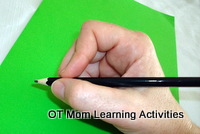 Handwriting requires good pencil control
Handwriting requires good pencil controlA child with poor hand function...
- may have hands which tire easily during fine motor tasks
- may struggle to grip and manipulate pencils, scissors and other tools
- may struggle to isolate the finger movements needed for playing a musical instrument or typing
Giving your child lots of opportunities to get the hands and fingers working together will improve hand strength and dexterity. Cutting with scissors is a really good way to help a child to develop good hand function.
Need help getting started? Try these affordable, printable resources with reams of activities at your fingertips!
Foundation 4: Bilateral Coordination
It may seem like a strange foundation for fine motor development, but if both hands don’t work well together, the ability to do many fine motor tasks may be affected. Eg.:
- You need one hand to hold and turn the paper while the other hand uses the scissors.
- You need one hand to hold the fork while the other hand cuts with the knife.
A child with poor bilateral coordination...
 Both hands working together
Both hands working together- may struggle to use a knife and fork together
- may struggle to hold a piece of paper while cutting
- may struggle with tying shoelaces
- may avoid playing with playing with construction toys, nuts and bolts...
- may avoid beading, knitting, sewing and other two-handed craft activities
Read more about the importance of bilateral coordination.
Need quick and easy bilateral activities to do with your child?
Try this e-book full of ideas that you can do at home on a tight budget!
Other Factors That May Cause Poor Fine Motor Skills
In addition to the underlying foundations I mention above, there are other factors that can affect your child’s progress in developing hand and finger skills. Genetics, access to resources, parental support and guidance, and underlying medical conditions, can all affect the development of fine motor skills.
In addition time spent on devices often outweighs time spent in hands-on activities, which means kids don't get as many opportunities to develop fine motor skills.
Signs Of Poor Fine Motor Skills
- Gets frustrated with fine motor activities
- Struggles to hold scissors or crayons efficiently
- Tires easily during fine motor tasks
- Avoids drawing and coloring
- Struggles to keep up with peers in written tasks
If you notice any of these signs of poor fine motor skills in your child, then you may need to seek additional support. If you are at all concerned about your child’s development, please consult an occupational therapist for professional guidance.
These pages of my site may be helpful if you want to support your child’s normal development. There are lots of ideas for screen-free activities in these pages!
- Understanding what makes a functional pencil grasp
- Hand strengthening exercises for kids
- Pencil control exercises
- Help your child learn to cut along a line
- Letter formation activities and tips (that don’t use a pencil)
- Fine Motor Activities Resource E-Book
Tips and Activities for Fine Motor Development
- Give your child lots of opportunities to use their hands in different ways – squeezing, grasping, transferring items, picking up items, engaging in kitchen activities and playing with playdough. This will often mean encouraging your child to spend time away from their devices!
- Play is crucial! Whether playing with lego, dressing and undressing dolls, putting together construction toys, or building puzzles, playing will get your child’s hands active and can help improve strength and dexterity. If your child struggles to play, then try spending some time playing with your child to show them how to make the most of different toys.
- These activities for kindergarten readiness will help prepare your preschooler for handwriting and other fine motor tasks they'll encounter at school.
- Learning Resources is a company that has created some lovely fine motor toys and games. Have a look at their resources on Amazon #Ad and consider a fine motor toy as a birthday gift!
- Look out for craft activities like cutting and pasting, stringing beads and making collages – there are often lots of seasonal ideas available for parents to do with their kids. Try these printable Christmas fine motor activities.
- Get dozens of fun hands-on, screen-free activities at your fingertips in my Fine Motor Activities e-book. Designed for busy parents who want easy ideas to do at home with their kids!
Developing good fine motor skills is an important part of your child’s development, and can help them achieve independence in daily tasks and achieve success in school.
I hope you feel inspired to promote your child's optimal progress!
Sign up for my occasional, free newsletter to stay in touch with new activities and updated pages!
- Home Page
- About Fine Motor Skills
- Fine Motor Development: essential information
Share this page to help others!
References
- Fine Motor Developmental Chart
- The development of fine motor skills in children
- Parush, S.; Levanon-Erez, N., Weintraub, N. Ergonomic factors influencing handwriting performance. Work 11(1998) p295-305
- Benbow, M. Neurokinesthetic approach to hand function and handwriting . Albuquerque: Clinician’s View, 1995
Didn't find what you were looking for? Try a search of my site!
